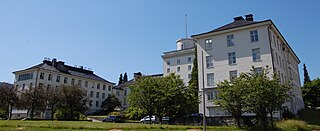
La Niña is an oceanic and atmospheric phenomenon that is the colder counterpart of El Niño, as part of the broader El Niño–Southern Oscillation (ENSO) climate pattern. The name La Niña originates from Spanish for "the girl", by analogy to El Niño, meaning "the boy". In the past, it was also called an anti-El Niño and El Viejo, meaning "the old man."

Harald Ulrik Sverdrup was a Norwegian oceanographer and meteorologist. He served as director of the Scripps Institution of Oceanography and the Norwegian Polar Institute.

The American Geophysical Union (AGU) is a 501(c)(3) nonprofit organization of Earth, atmospheric, ocean, hydrologic, space, and planetary scientists and enthusiasts that according to their website includes 130,000 people. AGU's activities are focused on the organization and dissemination of scientific information in the interdisciplinary and international fields within the Earth and space sciences. The geophysical sciences involve four fundamental areas: atmospheric and ocean sciences; solid-Earth sciences; hydrologic sciences; and space sciences. The organization's headquarters is located on Florida Avenue in Washington, D.C.

Kevin Edward Trenberth was part of the Climate Analysis Section at the US NCAR National Center for Atmospheric Research. He was appointed Distinguished Scholar at NCAR in 2020. He is also an honorary faculty member in the Physics Department at the University of Auckland, New Zealand. He was a lead author of the 1995, 2001 and 2007 IPCC Scientific Assessment of Climate Change and served on the Scientific Steering Group for the Climate Variability and Predictability (CLIVAR) program. He chaired the WCRP Observation and Assimilation Panel from 2004 to 2010 and chaired the Global Energy and Water Exchanges (GEWEX) scientific steering group from 2010 to 2013. In addition, he served on the Joint Scientific Committee of the World Climate Research Programme, and has made significant contributions to research into El Niño-Southern Oscillation.

Gavin A. Schmidt is a British climatologist, climate modeler and Director of the NASA Goddard Institute for Space Studies (GISS) in New York, and co-founder of the award-winning climate science blog RealClimate.

Jonathan Michael Gregory is a climate modeller working on mechanisms of global and large-scale change in climate and sea level on multidecadal and longer timescales at the Met Office and the University of Reading.

John Alexander Church is an expert on sea level and its changes. He was co-convening lead author for the chapter on Sea Level in the IPCC Third Assessment Report. He was also a co-convening lead author for the IPCC Fifth Assessment Report. He is a member of the Joint Scientific Committee of the WCRP. He was a project leader at CSIRO, until 2016. He is currently a professor with the University of New South Wales' Climate Change Research Centre.

Robert Merlin Carter was an English palaeontologist, stratigrapher and marine geologist. He was professor and head of the School of Earth Sciences at James Cook University in Australia from 1981 to 1998, and was prominent in promoting climate change denial.
William Richard Peltier, Ph.D., D.Sc. (hc), is university professor of physics at the University of Toronto. He is director of the Centre for Global Change Science, past principal investigator of the Polar Climate Stability Network, and the scientific director of Canada's largest supercomputer centre, SciNet. He is a fellow of the Royal Society of Canada, of the American Geophysical Union, of the American Meteorological Society, and of the Norwegian Academy of Science and Letters..
Robert (Bob) Stephen White is Professor of Geophysics in the Earth Sciences department at Cambridge University and was elected a Fellow of the Royal Society (FRS) in 1994. He is Director of the Faraday Institute for Science and Religion.

Andrew Emory Dessler is a climate scientist. He is Professor of Atmospheric Sciences and holder of the Reta A. Haynes Chair in Geoscience at Texas A&M University. He is also the Director of the Texas Center for Climate Studies. His research subject areas include climate impacts, global climate physics, atmospheric chemistry, climate change and climate change policy.
Haugan is a Norwegian surname which originated as a farm name. The name Haugan derives from the Old Norse word haugr which can be translated to mean hill, knoll, or mound. Other derivatives include Hauge, Haugen and Haugland, all common Norwegian surnames. Haugan may refer to:

The Geophysical Institute, University of Bergen is a marine research facility located in Bergen, Norway. Founded in 1917 by Bjørn Helland-Hansen, the institute studies the field of oceanography dealing with the patterns of the weather in the North Atlantic Ocean off the coast of Norway. Within recent years, focus has been increasingly on geophysics and environmental research. The research activities at the institute span from small scale measurement of turbulence up to studies of the large scale ocean currents, from local air and noise pollution up to studies of global scale climate change.

Prem Chand Pandey is an Indian space scientist, planetary scientist, and academic in the fields of satellite oceanography, remote sensing, atmospheric science, the Antarctic and climate change, and also he is the founding director of the National Centre for Polar and Ocean Research (NCPOR).

Bhupendra Nath Goswami is an Indian meteorologist, climatologist, a former director of the Indian Institute of Tropical Meteorology (IITM). and a Pisharoty Chair Professor at the Indian Institute of Science Education and Research. He is known for his researches on the Indian monsoon dynamics and is an elected fellow of all the three major Indian science academies viz. Indian National Science Academy, Indian Academy of Sciences, and the National Academy of Sciences, India as well as The World Academy of Sciences. The Council of Scientific and Industrial Research, the apex agency of the Government of India for scientific research, awarded him the Shanti Swarup Bhatnagar Prize for Science and Technology, one of the highest Indian science awards for his contributions to Earth, Atmosphere, Ocean and Planetary Sciences in 1995.
Shyam Sundar Rai is an Indian seismologist and a former chair professor at the department of Earth and Climate Science of the Indian Institute of Science Education and Research, Pune. He is known for his researches on the seismic structure of Indian continental lithosphere and is an elected fellow of all the three major Indian science academies viz. Indian National Science Academy, Indian Academy of Sciences, and the National Academy of Sciences, India as well as of the Indian Geophysical Union. The Council of Scientific and Industrial Research, the apex agency of the Government of India for scientific research, awarded him the Shanti Swarup Bhatnagar Prize for Science and Technology, one of the highest Indian science awards for his contributions to Earth, Atmosphere, Ocean and Planetary Sciences in 1996.

Rengaswamy Ramesh (1956–2018) was an Indian climatologist, oceanographer, a former Prof. Satish Dhawan Professor at the Physical Research Laboratory and a senior professor at the National Institute of Science Education and Research, Bhubaneswar. He was known for paleo-climatic and paleo-oceanographic studies and was an elected fellow of all the three major Indian science academies viz. Indian National Science Academy, Indian Academy of Sciences, and the National Academy of Sciences, India as well as of The World Academy of Sciences. The Council of Scientific and Industrial Research, the apex agency of the Government of India for scientific research, awarded him the Shanti Swarup Bhatnagar Prize for Science and Technology, one of the highest Indian science awards for his contributions to Earth, Atmosphere, Ocean and Planetary Sciences in 1998.
Sreedharan Krishnakumari Satheesh is an Indian meteorologist and a professor at the Centre for Atmospheric and Oceanic Sciences of the Indian Institute of Science (IISc). He holds the chair of the Divecha Centre for Climate Change, a centre under the umbrella of the IISc for researches on climate variability, climate change and their impact on the environment. He is known for his studies on atmospheric aerosols and is an elected fellow of all the three major Indian science academies viz. Indian Academy of Sciences Indian National Science Academy and the National Academy of Sciences, India as well as The World Academy of Sciences. The Council of Scientific and Industrial Research, the apex agency of the Government of India for scientific research, awarded him the Shanti Swarup Bhatnagar Prize for Science and Technology, one of the highest Indian science awards for his contributions to Earth, Atmosphere, Ocean and Planetary Sciences in 2009. He received the TWAS Prize of The World Academy of Sciences in 2011. In 2018, he received the Infosys Prize, one of the highest monetary awards in India that recognize excellence in science and research, for his work in the field of climate change.
Michael Ghil is an American and European mathematician and physicist, focusing on the climate sciences and their interdisciplinary aspects. He is a founder of theoretical climate dynamics, as well as of advanced data assimilation methodology. He has systematically applied dynamical systems theory to planetary-scale flows, both atmospheric and oceanic. Ghil has used these methods to proceed from simple flows with high temporal regularity and spatial symmetry to the observed flows, with their complex behavior in space and time. His studies of climate variability on many time scales have used a full hierarchy of models, from the simplest ‘toy’ models all the way to atmospheric, oceanic and coupled general circulation models. Recently, Ghil has also worked on modeling and data analysis in population dynamics, macroeconomics, and the climate–economy–biosphere system.

Axel Timmermann is a German climate physicist and oceanographer with an interest in climate dynamics, human migration, dynamical systems' analysis, ice-sheet modeling and sea level. He served a co-author of the IPCC Third Assessment Report and a lead author of IPCC Fifth Assessment Report. His research has been cited over 18,000 times and has an h-index of 70 and i10-index of 161. In 2017, he became a Distinguished Professor at Pusan National University and the founding Director of the Institute for Basic Science Center for Climate Physics. In December 2018, the Center began to utilize a 1.43-petaflop Cray XC50 supercomputer, named Aleph, for climate physics research.